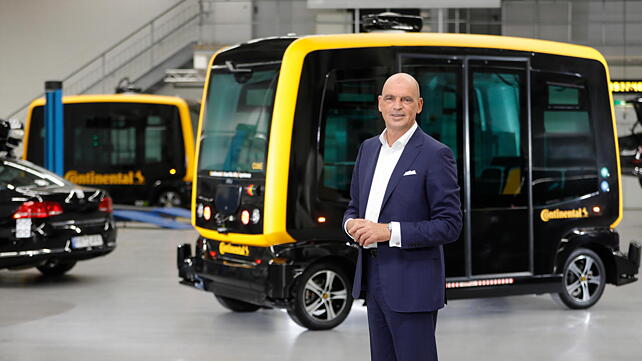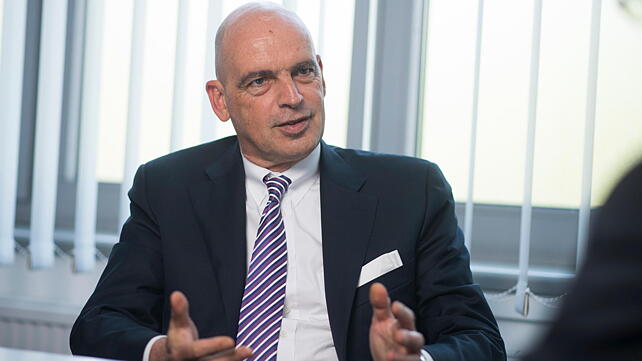
Frank Jourdan is currently Member of the Executive Board of Continental AG and Head of the Autonomous Mobility and Safety business area. He studied engineering and has a background in software. He joined the company in 1988. He has been a member of the Executive Board since September 2013 as head of the Chassis & Safety division, based in Frankfurt am Main. He had previously spent four years in charge of the Vehicle Dynamics business unit.
As if the global automotive slowdown wasn’t enough, the world was hit by the COVID-19 outbreak last year. From where we stand today, how do you look into the future?
The year 2020 was by far the most challenging year of the last decades. The automotive industry was already struggling in 2019 due to various factors. It was hit hard by the COVID-19 pandemic, which brought the industry to a complete standstill for few months globally – an event that is essentially the first of its kind for all of us.
The shutdown of automotive production during the lockdown period affected us in many ways. The disruptions caused by the Coronavirus crisis have caused extreme volatility in the automotive industry. After the industry shutdown in the early phase of the crisis and the resulting abrupt drop in demand, automobile manufacturers across all regions increased their production volumes much faster than expected by market experts. This resulted in large scale supply shortages for semiconductors. With lead times of six to nine months, the semiconductor industry has not been able to scale up fast enough to meet this unexpected growth in automotive demand.
Additionally, in the recent weeks there have been a number of unforeseen, significant events that have impacted Continental and our supply chain partners, such as the Japan earthquake and the snowstorm in Texas and the Southern United States, as well as Northern and Central Mexico.
Amid a historically weak market environment, Continental demonstrated operational and financial resilience in fiscal 2020 and achieved its adjusted annual targets. In operational terms, we fared well in 2020 under the circumstances and generated solid positive free cash flow. We mitigated the economic impact of the COVID-19 pandemic by being well-disciplined with its expenses and capital expenditure but had also to take painful decisions for employees affected by our transformation programme.
In 2020, we also enhanced our technological expertise and brought safe, connected, convenient and sustainable mobility to the streets in millions of vehicles. We launched more than 800 production series worldwide in a pandemic-safe manner and delivered more than 1.4 billion components and systems in the Automotive Technologies group sector alone. We have also continued to invest in R&D towards newer technologies.
As part of our new strategy, we will focus on two different forms of value creation in our portfolio – ‘growth’ and ‘value’. These have two different objectives and require two different management methods. Both are equally important, and we will be successful only when we combine both. Within our Automotive Technologies group sector, the action fields Autonomous Mobility, Smart Mobility, Architecture and Networking and Software and Systems Excellence are focused on ‘growth’. Safety and User Experience focus on ‘value’.
Within our Automotive Technologies group sector, the action fields Autonomous Mobility, Smart Mobility, Architecture and Networking and Software and Systems Excellence are focused on ‘growth’. Safety and User Experience focus on ‘value’.
In the future, we will rely heavily on our growth fields and future technologies, striving to achieve above-average profitable growth here. At the same time, we will secure value contributions in those product areas that have already established leading positions in a saturated market environment.
While business projections may have been redrafted, the fundamentals of the future of mobility sector remain unaltered. What are your thoughts?
The future of mobility is characterised by its high degree of connectivity and safety as well as its convenience – regardless of the vehicle’s drive system. While hardware is still important, software will increasingly make the difference in the future. With our future-oriented technologies and our success-driven, global team and extensive software expertise we set us apart from others in the mobility market.
What is for sure is that we will continue our road tests for automated and autonomous driving in complex environments in FY21. We will also realise technological advances and numerous new production start-ups in multiple areas, including brake systems, networking in 5G and ultra-wideband (UWB), material development, and human-machine interaction.
Specific to shared mobility, what sort of changes do you foresee coming in, considering consumer’s reluctance to use public transportation in the wake of the pandemic?
The shared mobility trend has taken a backseat post-pandemic. As per Continental’s Mobility Study last year, private car use has seen strong growth, while sharing and hailing services, which had been booming in recent years pre-COVID-19, are suffering a significant slump. People in France, the US, Japan and Germany remain largely loyal to traditional mobility concepts: shared mobility in the form of vehicle sharing or spontaneous hailing plays almost no role in the four countries. In China, meanwhile, one in 10 people continue to use these services.

But we might see a recovery in the long run with confidence being instilled among the users once the vaccination is comprehensively covered. Shared mobility and concepts like robo-taxis will play a key role in future smart city scenarios.
Much development can be seen in the EV world, but making EVs a mass mobility sustainable option still seems to be a distant dream. Moreover, the concerns and challenges associated with EVs – charging infrastructure, range, price, etc. – continue to remain relevant in almost every market. How do you assess the progress the industry is making in terms of products, systems, and technologies?
While some short-term challenges need to be worked upon, in the long term, we should expect a higher adoption rate across the world, including India. According to a report released by KPMG in November 2020, electric two-wheeler penetration in India is expected to reach 25-35% and that of e-three-wheelers at 65-75% by 2030.
In India specifically, various norms launched by the government like FAME I, FAME II, and various tax sops to promote electric vehicles launched by the Indian government are giving the much-needed push to the transformation.
Recently, we gave the green light to continue proceedings aimed at establishing the entrepreneurial independence of Vitesco Technologies – a trailblazer in the field of powertrain electrification (earlier powertrain division of Continental).
At Continental, we are contributing to electrification technologies and systems that are universal to drivetrain such as the braking, connectivity, solutions for human-machine interaction, high-performance computers, assisted driving, vehicle architecture, and security. These technologies help in optimising the performance and range of the electric vehicle as well as increasing safety and user experience.
The setting up of an independent ‘Autonomous Mobility’ business vertical clearly confirms Continental’s focus in the areas of advanced driver assistance and automated driving. Could you give us a sense of the kind of development work being done in this area?
The automotive industry is undergoing major changes. Not only in terms of technology, but also in terms of business models. We are currently experiencing very strong market momentum in the field of autonomous mobility. The autonomous mobility market will more than double in the next three years. Just from 2018 to 2020, Continental received orders in this area totalling more than €9 billion from car manufacturers worldwide. We intend to increase this amount substantially, as the potential scope of Continental’s supply will go up in value many times over the coming years as the degree of automation grows.
That is also why we are now implementing our strategy and boosting our autonomous mobility activities, spending an additional €200-250 million in our driver assistance and automated driving systems business in 2021.
We are committed to becoming represented on the market not just as a component supplier but also as a comprehensive systems provider. This will make us a larger part of the rapidly growing market for autonomous mobility. We thus would like to grow in our key fields of expertise, which are vital for the future. These include, for example, the following: strong sensor and functions portfolio, expansion of functional and systems capability, perception at the system level, software for driving functions, system integration and data management.
The decisive success factor in all these areas is the capacity to respond quickly to rapidly changing requirements. The underlying innovation processes are like those in the IT industry.
From January 1, 2022, we are establishing the Advanced Driver Assistance Systems business unit as an Autonomous Mobility business area within the Automotive Technologies group sector. This new business area will further contribute to our Vision Zero: Zero Fatalities, Zero Injuries, Zero Crashes, and consolidate vital expertise and enhance our focus on this future market.
You’ve spoken in the past about Continental getting more involved with city infrastructure and service providers therein. Could you give us an update on that?
We announced a big step in 2019 toward creating smarter cities: A Smart City Mobility and Transportation Hub in Auburn Hills, Michigan/US and added a second hub in 2020 in Columbus, Ohio/US. At the centre of both hubs are busy intersections with high vehicle and pedestrian traffic, made intelligent by integrating Continental sensors, connectivity, and intelligent software into the infrastructure.
This technology has the potential to improve traffic flow, add convenience, reduce pollution and, most importantly, significantly increase the intersection’s safety by communicating hidden dangers to approaching connected vehicles and pedestrians. An additional feature added in Auburn Hills is our Wrong-Way Driver detection system, which warns at-risk drivers in the vicinity of a driver heading the wrong way.
Continental’s Intelligent Intersection is an end-to-end solution comprising a sensor set for the intersection, the powerful sensor (Radar, Camera, LiDAR) fusion algorithms that generate the environment model, and the Dedicated Short-Range Communication (DSRC) units, both at the intersection, and in the vehicle. While the concept is integral to protecting Vulnerable Road Users (VRUs) such as pedestrians and cyclists, it can also support drivers in complex intersection traffic scenarios like preventing right-turning cars from running head-on into traffic that approaches from behind an occlusion.
In Columbus, Continental is also building a dashboard, where all collected data can be visualised for city officials. This dashboard will help the city monitor the overall system, can enable over-the-air updates for new feature deployments and system maintenance, and will ultimately give a previously unseen look into traffic patterns and critical moments, like near-miss crashes and vulnerable road user behaviour, which can be used to improve safety and increase efficiency.

As one of Continental’s key markets, how do you view the developments in India – from a business perspective, as well as a technology development perspective?
India is the largest two-wheeler market in the world and is expected to grow and become the third-largest automotive market by 2025. From a business perspective, India is a critical market for Continental. With an ‘in the market, for the market’ approach, we have been consistently investing in India and will continue to do so – for example, a capacity expansion for Airbag Control Units in Bengaluru, Wheel Speed Sensors in Manesar in 2019 and 2020. Another example is the launch of a new greenfield project in Pune in December 2018 for premium Interior Surface solutions.
From a technology development perspective, we have taken various steps to localise technology development in India. For instance, we established in 2009 our Technical Center India (TCI). The centre operates out of Bengaluru with close to 4,000 engineers and supports R&D in all automotive divisions of the company, both at a local and global level. Within a short time, TCI has built competencies across domains and has a large engineering workforce working on areas such as advanced safety technologies, autonomous driving technologies, connected mobility, and affordable solutions for the local requirement.
TCI is today the global software centre for excellence and the headquarters of the Software Academy, in addition to emerging as the Regional R&D centre and Asia Application Hub for businesses in specific markets. It houses centres of competence in niche areas, including machine learning.
We are decisively tackling the digitalisation, electrification, and automation of mobility and are focusing our R&D activities more strongly on our customers' increased requirements in these areas.
Finally, how would you sum up the opportunities for Continental, and specifically the autonomous mobility & safety domains, in the years to come?
India has been focused on improving road safety for the last few years. We’ve seen the introduction of policies that made ABS mandatory for bikes over 125cc, airbags in cars, etc. Further, Ministry of Road Transport and Highways’ decision to mandate airbags for the passenger seated at the front seat of the vehicle, next to the driver, in new cars post April 1, 2021, and older models by August 31, 2021 is a positive move towards increasing levels of vehicle safety.
Consumer awareness of vehicle safety technologies is on the rise, which adds demand for OEMs. Features like ESC, Parking Assist, Cruise Control, and Tyre Pressure Monitoring System (TPMS) are among the features that are expected in a vehicle today. With our overarching Vision Zero, we are working on bringing globally proven safety technologies to the local market at a competitive price. This is achieved through the innovation and competence of the R&D workforce.
All these create great opportunities for advanced safety technologies in India. Further, over the next few years, we expect technologies like ESC to gain prominence, driven by policy, increased consumer awareness, and consumer choice as the automotive industry begins focusing on more assisted driving functions in vehicles to enhance safety.